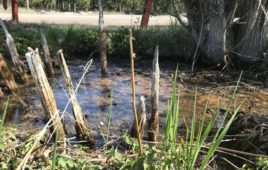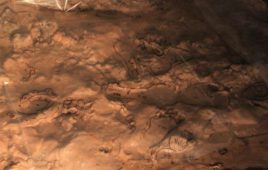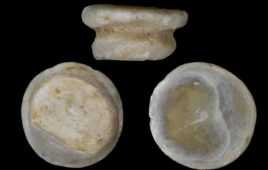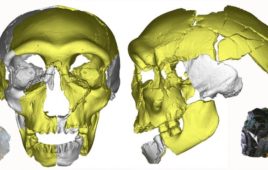Kevin Johnson, an ornithologist with the Illinois Natural History Survey, led a study of fossils and molecular data to track the evolution of lice and their hosts. Credit: L. Brian Stauffer |
A new study louses up a popular theory of animal evolution and opens up the
possibility that dinosaurs were early—perhaps even the first—animal hosts of
lice.
The study, in Biology
Letters, uses fossils and molecular data to track the evolution of lice and
their hosts. It offers strong evidence, the researchers said, that the
ancestors of lice that today feed on birds and mammals began to diversify
before a mass extinction event killed off the dinosaurs about 65 million years
ago.
“This study lends support to the idea that major groups of
birds and mammals were around before the dinosaurs went extinct,” said Kevin
Johnson, an ornithologist with the Illinois Natural History Survey at the Univ. of Illinois and a principal investigator on
the study. “If the lice were around, we know their hosts were probably around.”
Scientists still are trying to understand the factors that
led to the diversity of today’s birds and mammals. One theory is that the
extinction of the dinosaurs fostered the earliest stages of bird and mammal
diversification and expansion (a process called “radiation”) by opening vast
new territories and types of habitats to them.
“Ducks do different things from owls, which do different
things from parrots, for example,” Johnson said, “and it was thought that after
the dinosaurs went extinct that’s when these birds or mammals diversified into
these different niches.”
“But based on the evidence from lice, the radiation of birds
and mammals was already under way before the dinosaurs went extinct,” he said.
Lice have developed unique methods for evading a host’s
defenses. Wing lice, for example, have elongated bodies that allow them to
insert themselves between the barbs in a feather and thus evade preening.
Gopher lice have grooves in the tops of their heads that clasp onto a single
shaft of hair. This specialization makes it hard for lice to shift to other
hosts. As a result, their evolutionary history coincides very closely with that
of their hosts.
Fossil and extant lice. Credit: Univ. of Illinois at Urbana-Champaign |
Johnson and his colleagues, including co-principal
investigator Vincent Smith (a former postdoctoral researcher in Johnson’s lab
who now is at the Natural History Museum in London) built a partial family tree of lice
by comparing the DNA sequences of genes from 69 present-day louse lineages.
Changes in gene sequence are a reliable measure of relatedness among different
species in the same group (organisms in the same order, family or genus, for
example). And because these changes accumulate over time, they also can be used
to create a rough timeline of the evolution of related groups of organisms.
“Lice are like living fossils,” Smith said. “The record of
our past is written in these parasites, and by reconstructing their
evolutionary history we can use lice as markers to investigate the evolutionary
history of their hosts.”
The researchers used louse, bird, and mammal fossils to
anchor precise time points in the tree. These fossils are dated according to
the age of the geologic formations in which they were found. This gives only a
minimum age for the animal found embedded there, Johnson said.
“If the oldest dove fossil is 20 million years old, we know
that doves must have been around at that time,” Johnson said, “so we know that
the split that occurred between doves and the closest relative of doves must
have occurred before 20 million years ago.”
The oldest fossils found so far that resemble modern bird
and mammal groups are less than 65 million years old, Johnson said. This led to
the hypothesis that major bird and mammal lineages appeared only after the
dinosaurs went extinct.
But more recent studies of the genetic changes in major
groups of birds and mammals suggest that many of them were around before the
dinosaurs disappeared.
The new study supports this idea, Johnson said.
“Our analysis suggests that both bird and mammal lice began
to diversify before the mass extinction of dinosaurs,” Johnson said. “And given
how widespread lice are on birds, in particular, and also to some extent on
mammals, they probably existed on a wide variety of hosts in the past, possibly
including dinosaurs.”
Many scientists believe that birds are the descendants of
feathered dinosaurs, Johnson said. “So maybe birds just inherited their lice
from dinosaurs.”






